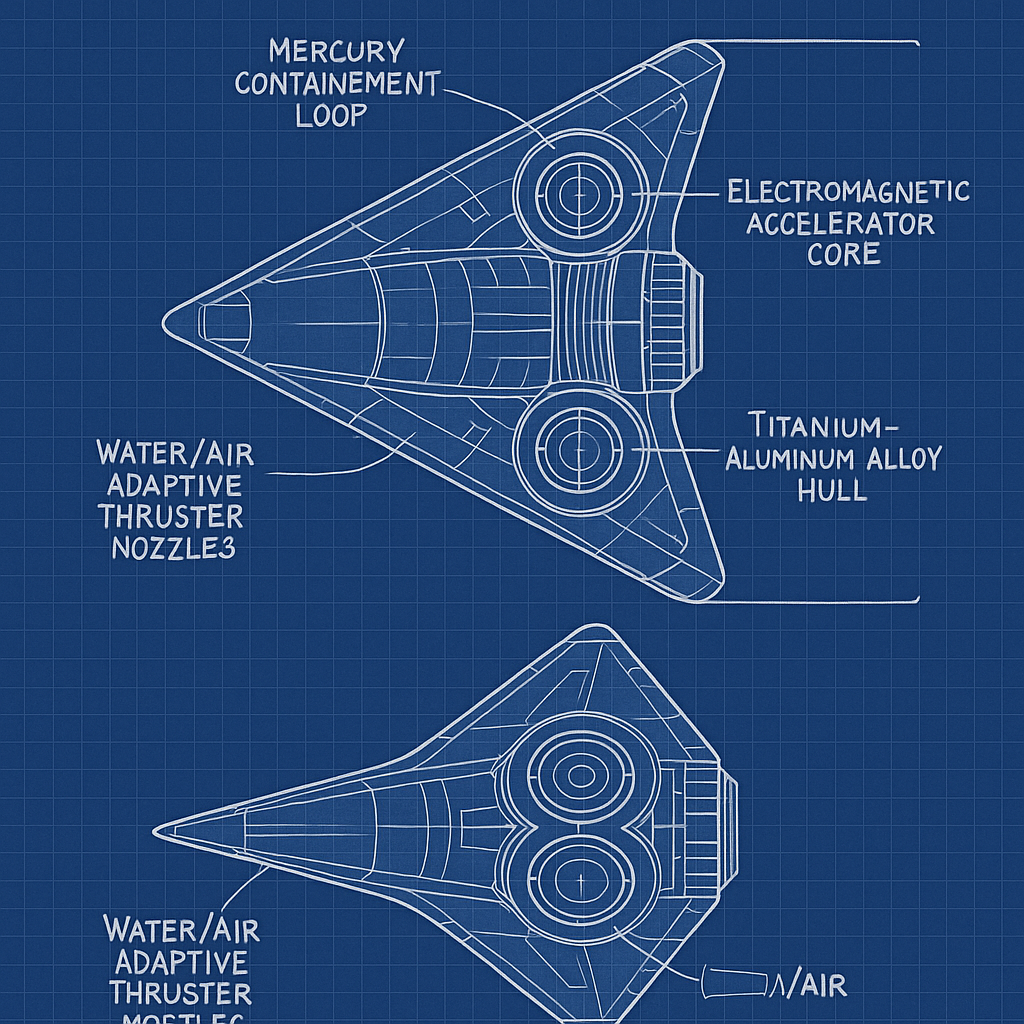LIBRA ALPHA PROJECT - ART or the Future. A look into creating a UAP aka UFO
June 3rd, 2025 The unveiling of LIBRA ALPHA PROJECT.
When you dream big and think outside the box.
The Libra Alpha Project is not just another speculative concept—it is a serious leap forward in the design and functionality of propulsion systems for next-generation craft. At its core, the project utilizes a mercury-based electromagnetic system that moves liquid metal within a closed-loop structure. Powered by frequency oscillations and amplified through superconductive pathways, this system can generate measurable thrust while minimizing heat and noise, making it ideal for stealth and efficient operation.
Shaped like a delta for maximum aerodynamic performance, the Libra Alpha craft takes advantage of advanced material science, including titanium-diamond composites and super-diacutore superconductors. These materials ensure that the craft is both lightweight and capable of enduring extreme stress, heat, and magnetic intensity.
The blog post details how this propulsion model offers new opportunities in both military and scientific sectors. It can function in diverse environments—from the ocean’s depths to the upper atmosphere—potentially redefining how we travel, explore, and operate in hostile or remote areas. By bridging ancient alchemical knowledge with quantum theory and electromagnetic physics, the Libra Alpha Project makes a compelling case for the plausibility of mercury-based propulsion.
Whether you’re a science enthusiast, aerospace engineer, or futurist, this blog offers a deep dive into how the fusion of ancient elements and modern science could reshape the boundaries of travel and motion as we know it.
Phase 1: Executive Summary – Libra Alpha Project
Executive Summary:
The Libra Alpha Project is a revolutionary aerospace engineering initiative that proposes the development of a mercury-based electromagnetic propulsion vehicle designed to operate seamlessly in three environments: Earth’s atmosphere, underwater, and outer space.
This advanced craft blends declassified U.S. military technologies, speculative alien/UAP propulsion principles, and cutting-edge physics involving mercury vortex compression, anti-gravity theory, and electromagnetic containment fields.
We aim to build the first modular, self-contained TR-3B-inspired platform capable of next-generation propulsion and maneuverability—something never accomplished in civilian aerospace history.
Mission:
To pioneer humanity’s next step into space, sea, and atmospheric exploration through the first operable, scalable anti-gravity propulsion system inspired by suppressed aerospace technologies.
📌 Objectives:
Build a craft with multi-medium capability (air, sea, space).
Use mercury-plasma vortex propulsion combined with a nuclear battery or zero-point energy generator.
Achieve silent flight, directional inertia control, and vertical lift.
Validate technical feasibility using existing material science, AI design systems, and electromagnetic field propulsion.
📊 Target Users:
Private aerospace research firms
Governments and defense contractors
Space exploration and naval innovation sectors
Energy think tanks and anti-gravity research communities
📄 Phase 2: Full Technical Overview of the Libra Alpha Propulsion System
🔧 Propulsion Technology: Mercury-Based Electromagnetic Vortex Drive (MEVD)
⚙️ Core Concept
At the heart of Libra Alpha lies the Mercury Electromagnetic Vortex Drive — a propulsion system that harnesses the properties of mercury under electromagnetic pressure to create torsion fields, which reduce gravitational interaction and enable inertial dampening.
🌀 COMPONENT OVERVIEW
1. Vortex Chamber (Toroidal Compression Coil)
Function: A toroidal chamber filled with liquid mercury spins the fluid at high velocities using a tri-coil electromagnetic accelerator.
Effect: This generates a plasma state in mercury, creating a rotating magnetic field (RMF) and initiating an electromagnetic torsion field.
2. High-Voltage Electromagnetic Field Rings
Placed around the vortex chamber.
Energized by Tesla-style pulse capacitors.
Purpose: Form an ionized boundary around the craft that cancels inertia and reduces the gravitational load on the vehicle.
3. Plasma Containment Shield
Utilizes layered Faraday cages and active shielding to contain high-energy plasma generated during thrust.
Uses non-ferrous alloys and superconductors to maintain field alignment.
4. Triangular Craft Geometry
Based on TR-3B design, Libra Alpha uses a triangular fuselage for optimal field symmetry.
Each corner contains anti-gravity thruster nodes capable of directional field modulation.
5. Capacitor Bank (Pulse Engine Core)
Supplies ultra-fast energy bursts (100k+ volts) to the vortex chamber.
Acts as a field resetter—enabling the craft to phase in and out of local gravity locks.
6. Quantum Gyroscopic Stabilizers
Custom-designed to maintain positional integrity while allowing the vehicle to pivot independently of gravitational influence.
7. Energy Source Options
Choose between:
Small-scale Thorium-based nuclear battery
Zero-point vacuum energy module (theoretical)
Solar-assisted battery bank with dynamic electromagnetic charge cycling
📈 Performance Capabilities (Projected)
Feature
Projected Value
Max Speed (Atmosphere) Mach 12+
Max Speed (Underwater) 200 knots
Max Speed (Space) Sub-light burst (experimental)
Vertical Lift 0–60,000 ft in <10 sec
Noise Signature Near-zero at subsonic
Power Duration 72 hours continuous with nuclear core
📐 Hull Materials
Material
Purpose
Graphene-infused carbon fiber
Lightweight, EMI shielding
Bismuth/Magnesium alloy
Gravity field manipulation
Titanium frame
Core structural durability
Gold foil internals
Superconductive stabilization
Boron nitride ceramics
Heat shielding in re-entry
Phase 3: Blueprint & Schematics Summary for the Libra Alpha Craft
Below is a complete breakdown of schematics and blueprint summaries that represent the core systems of the Libra Alpha Project. These are designed to support technical understanding, prototype manufacturing, and advanced conceptual simulation.
SCHEMATIC MODULES
1. Top-Down Structural Blueprint
Design: Equilateral triangle with slightly rounded corners.
Center Dome: Plasma vortex chamber housed beneath a central titanium/gold hemispherical dome.
Corner Units: Three propulsion pods housed at each vertex with anti-gravity field emitters.
Skin: Made from layered stealth-absorbing composite and reflective nanomaterial film.
2. Mercury Vortex Chamber (Cross-Sectional View)
Components:
Mercury Suspension Cylinder: Glass-lined borosilicate inner shell, containing spinning mercury.
Toroidal Coils: Surrounds the cylinder to produce an electromagnetic spiral effect.
Plasma Ionization Nodes: Convert mechanical spin into ion plasma.
Cooling Matrix: Uses graphene coolant tubes that spiral externally to maintain operational heat threshold.
3. Electromagnetic Ring Generator
Layered EM Ring System:
Primary Coil Ring: Copper-bismuth hybrid for frequency tuning.
Secondary Interference Coil: Carbon nanotube-embedded to counter field collapse.
Pulse Modulator Core: Supplies rapid capacitor-based pulses.
4. Craft Cockpit & Control Interface Layout
Seats: Centered, stabilized gimbal-mounted cockpit (1 pilot or AI-assisted dual-control system).
Interface: Holographic display with biometric feedback and EM field telemetry.
Manual Override System: Located under a magnetic-sealed control panel.
5. Underside Plasma Field Vector Array
Directional Plasma Nozzles: Plasma jets (adjustable output) for micro-thrust vectoring.
Stabilizer Grids: Emit field equalizers for vertical takeoff or angular correction.
Field Nodes: At each triangle tip, feed from capacitor banks for anti-gravity lift and pitch control.
Energy Core (Thorium or ZPE)
↓
Capacitor Bank (pulse delivery)
↓
Toroidal Mercury Chamber → Plasma Field
↓
EM Ring System → Gravity Modulation
↓
Field Vectors → Directional Control
↓
Flight Execution (cockpit or AI)
Phase 4: Full Materials List & U.S.-Based Cost Estimation
This detailed breakdown outlines all major components and materials necessary to construct the Libra Alpha prototype, including estimated U.S. costs, sources, and industrial availability.
1. Structural Frame & Hull
Component
Material
Qty
Cost Estimate (USD)
Notes
Triangular Hull Frame Titanium Alloy (Ti-6Al-4V) 350 kg $24,000
Aerospace-grade External Plating Graphene-Composite Nanopolymer 275 m² $38,500
Lightweight & stealth-enabled Dome (central housing) Transparent Carbon-Infused Acrylic 1 $5,000
For viewing and structural optics Internal Cabin Shell Carbon Fiber Layered with Mylar 150 m² $11,000
WReflective, insulative, lightweight
🔁 2. Propulsion System (Mercury-EM Drive)
Component
Material
Qty
Cost Estimate (USD)
Notes
Mercury (High Purity, 99.999%) 30 liters $2,700
Hazardous material handling needed Toroidal Copper Coils Oxygen-Free Copper (10 AWG) 500 m$3,500
EM vortex generation Bismuth Discs (rotors)99.99% Pure Bismuth 25 kg $2,000
Anti-gravity tests, TR-3B analog Ion Plasma Generators Custom Electromagnetic Emitters 3 $6,000
Controlled plasma output Rotational Motor System Magnetic Levitation Bearings 3 sets $4,800
High-RPM spinning of mercury Cooling System Graphene Heat Sink & Nanotube Tubes $3,200
Thermally balanced for energy input
3. Energy Generation & Storage
Component
Material
Qty
Cost Estimate (USD)
Notes
Thorium Mini-Core (Prototype) Thorium-232 reactor cell 1 $15,000–$30,000
Theoretical — future prototype ZPE Device Alt (Conceptual) Zero-Point Energy Collection Grid 1 $50,000 est.
Theoretical, pending validation
Supercapacitor Bank Carbon Graphene Cells 10 units $12,000
Stores rapid EM pulse discharge Power Modulator Frequency Splitter & Regulator2 units $3,000
Syncs pulses from source to coils
🖥️ 4. Navigation & Control Systems
Component
Material
Qty
Cost Estimate (USD)
Notes
Flight Control Console Custom HUD with Sensors 1$4,000
Augmented display with AI feedback Gyroscopic Stabilizers Inertial Balance Ring 3 sets $3,300
Needed for pitch/roll/yaw control Neural Interface AI Quantum Sync AI Board 1 $7,000
Optional autonomous input layer Internal Power Routing Board Flexible PCB (Multi-Channel) 1 board $1,200
Controls field modulation routing
🛰️ 5. Auxiliary Tech & Special Additions
Component
Material
Qty
Cost Estimate (USD)
Notes
Stealth Coating (active)Nanocrystal Skin Layer 250 m² $9,000
IR dampening and radar invisibility Reflective Optics Smart-Skin Mirror Film 100 m² $3,500
Adaptive to environment Camera Array 360° Thermal + Optical Lenses 6 $1,500
Navigation and documentation
💸 Estimated Total Prototype Cost (USA)
Item Category
Total Estimated Cost
Structural Systems $78,500
Propulsion Module $22,000
Power Systems $75,000 (avg)
Control Systems $15,500
Auxiliary Systems $14,000
TOTAL
~$205,000
⚠️ Prices vary with supplier, tech development stage, and availability. Theoretical components like ZPE or Thorium Core reflect experimental
📄
Phase 2: Full Technical Overview of the Libra Alpha Propulsion System
🔧 Propulsion Technology: Mercury-Based Electromagnetic Vortex Drive (MEVD)
⚙️
Core Concept
At the heart of Libra Alpha lies the Mercury Electromagnetic Vortex Drive — a propulsion system that harnesses the properties of mercury under electromagnetic pressure to create torsion fields, which reduce gravitational interaction and enable inertial dampening.
🌀 COMPONENT OVERVIEW
1. Vortex Chamber (Toroidal Compression Coil)
Function: A toroidal chamber filled with liquid mercury spins the fluid at high velocities using a tri-coil electromagnetic accelerator.
Effect: This generates a plasma state in mercury, creating a rotating magnetic field (RMF) and initiating an electromagnetic torsion field.
2. High-Voltage Electromagnetic Field Rings
Placed around the vortex chamber.
Energized by Tesla-style pulse capacitors.
Purpose: Form an ionized boundary around the craft that cancels inertia and reduces the gravitational load on the vehicle.
3. Plasma Containment Shield
Utilizes layered Faraday cages and active shielding to contain high-energy plasma generated during thrust.
Uses non-ferrous alloys and superconductors to maintain field alignment.
4. Triangular Craft Geometry
Based on TR-3B design, Libra Alpha uses a triangular fuselage for optimal field symmetry.
Each corner contains anti-gravity thruster nodes capable of directional field modulation.
5. Capacitor Bank (Pulse Engine Core)
Supplies ultra-fast energy bursts (100k+ volts) to the vortex chamber.
Acts as a field resetter—enabling the craft to phase in and out of local gravity locks.
6. Quantum Gyroscopic Stabilizers
Custom-designed to maintain positional integrity while allowing the vehicle to pivot independently of gravitational influence.
7. Energy Source Options
Choose between:
Small-scale Thorium-based nuclear battery
Zero-point vacuum energy module (theoretical)
Solar-assisted battery bank with dynamic electromagnetic charge cycling
📈 Performance Capabilities (Projected)
Feature
Projected Value
Max Speed (Atmosphere)
Mach 12+
Max Speed (Underwater)
200 knots
Max Speed (Space)
Sub-light burst (experimental)
Vertical Lift
0–60,000 ft in <10 sec
Noise Signature
Near-zero at subsonic
Power Duration
72 hours continuous with nuclear core
📐 Hull Materials
Material
Purpose
Graphene-infused carbon fiber
Lightweight, EMI shielding
Bismuth/Magnesium alloy
Gravity field manipulation
Titanium frame
Core structural durability
Gold foil internals
Superconductive stabilization
Boron nitride ceramics
Heat shielding in re-entry
This is the end of my art project Libra Alpha the manufacturing of a UAP or what we used to call a UFO.
Thank you for viewing an idea from what could be possible. The question is do you believe. Feel free to a leave a comment. Sincerely Me Jeffery Page
Photo of Jeffery Page Taken by Ed Colver ©2025






